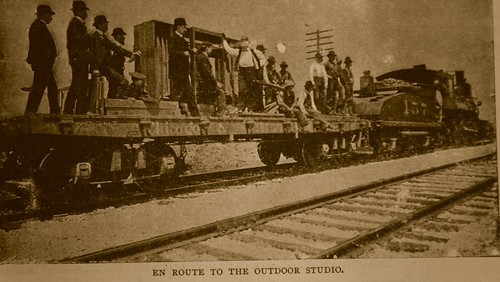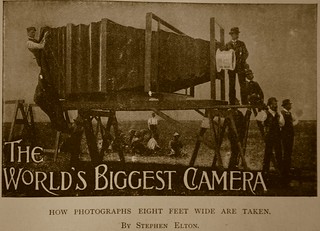George Raymond Lawrence

|
| 600kg Mammut camera w/ operation personnel on freight train scanned by Paul Jackson (Image rights) |
George Raymond Lawrence (born 1868 in Ottawa, Illinois, died 1938 in Chicago) was a famous photographer and inventor. Ca. 1890 he moved to Chicago were he married and founded a family. In 1891 he started a business as portraitist, sharing the studio with a photographer named Powell. When Powell abandoned his business in 1896, Lawrence took over his assets. He learned darkroom work from a friend. Then he started experimenting with flash light. After a lot of very dangerous experiments he found a magnesium powder mixture that gave more light and less smoke, thus making flash photography viable. Therefore he received the title "Father of Flash Photography" and the nickname "Flashlight Lawrence". When the magnesium powder flash method had become secure he had to convince authorities that it could be used without danger in the public. Finally he even got the permission to make a flashlight photograph of President McKinley.

|
| George Lawrence making an exposure with the Mammut, the largest camera of the World scanned by Paul Jackson (Image rights) |
In 1900 the Chicago & Alton Railroad Co. wanted to present a sensational photograph of its luxury train Alton Limited at the Expo of Paris. The complete train should be taken on one super large photo. Lawrence was engaged to do the job. The camera built for that purpose was a colossal view camera, weighing 1,400 pounds, and making a 8ft. × 4ft. 6in. exposure on a giant Cramer Isochromatic plate. Three prints of the photograph were made, and the image won a Grand Prix at the Expo.
Another specialty of Lawrence was panorama photography. In 1906 he shot a sensational panorama view of San Francisco, a 17 × 48 in. image taken with help of a kite from great height, 6 weeks after the great earthquake. He earned $ 15,000 from selling prints of the image.
In 1900 he invented a special purpose panorama camera, the banquet camera. First he was invited by J.P. Morgan to photograph a banquet given by the famous banker, despite of an indoor flashlight ban law. Later he convinced authorities that his new careful flash-photography methods were less dangerous so that he could also make banquet photos of Presidents McKinley and Philippines' Governor Taft, and the flashlight ban was withdrawn.
After divorce in 1913 he married again in 1916, founding another family.